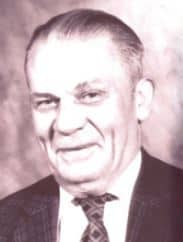Bob, as he was always known, Butterfield was born at Goldthorpe near Rotherham, on 1 November 1912.

He enlisted at Sheffield on 8 May 1931 on a ‘Six and Six’ year engagement for the Cavalry of the Line. He had previously been a miner.
On 9 May 1931, he joined The 8th K.R.I Hussars at Aldershot. During his time there he obtained his 3rd and 2nd Class Army Education Certificates.
Having spent a year at Aldershot and then a year at Hounslow, he and his fellow 8th Hussars set sail for Egypt, which would be their home for almost eight years.
On arrival at Abbassia on New Year’s Eve 1933, the Regiment spent the next eighteen months in typical fashion, mainly training parades.
In November 1935 there came a dramatic change when “the old hairies” departed and mechanisation commenced. The Regiment had a succession of drawing vehicles of various types and then having familiarised themselves with that particular type, would have to hand them in and draw different ones.
This did not deter them from deploying to the desert to carry out many “recces”, to acclimatise to desert conditions.
On 26 May 1937, Bob extended his engagement to a straight 12 years. Perhaps, as a reward for this, he gained his first step on the promotion ladder by being made a Lance Corporal (unpaid, of course).
Steady progress was made and on 3 December 1938, he was made a Corporal.
On 11 April 1939, he transferred to The Royal Armoured Corps, and in July of that year, he mustered as a Corporal Driver/ Mechanic. He had been appointed a Lance Sergeant a few weeks previously, and by the end of 1939 had become a substantive Sergeant.
Meanwhile, the Regiment had been preparing themselves for war. Much long-range patrolling was carried out in conjunction with intensive desert training. They became familiar with Mersa Matruh, Suma and Sollum, not forgetting “the wire” (on the Egyptian-Cyrenaica borders). They were also engaged with the RASC in establishing food and fuel dumps in the desert. A busy time for Bob, who was acting as the Transport Sergeant.
He continued to serve with the Regiment which had been at war with the Italians from July 1940 until late 1941.
He then left on a boat (which broke down in mid-ocean) as part of the escort taking Italian prisoners of war to South Africa.
On arrival back in the UK, he attended a gunnery instructor’s refresher course. After which he was posted to the Westminster Dragoons via the 60th Training Regiment RAC. He spent nearly two years with the Westminster Dragoons, during which The 8th Hussars had returned to the UK.
Immediately after this happened Bob applied to return to his Regiment. The Westminster were reluctant to part with him, but eventually, he got his wish and he rejoined The 8th in March 1944 at West Tofts.
Between then and his embarkation for N.W. Europe a few days after D Day, he spent a spell as an acting SQMS and in August of that year, he became substantive in that rank, having been promoted to a paid acting WO2 (SSM) two months previously.
On the 7th of June 1944, Bob crossed from Gosport and landed near Le Havre, and there began the long hard slog across France, the Low Countries and eventually on to Berlin, and Bob was present the whole time.
Bob had crossed as 21C ‘A’ Squadron echelon, the commander being the late “Bill” Bellamy, soon to be awarded a Military Cross. Bill obviously relied heavily on such an experienced WO.
The end of the war for The 8th Hussars came whilst they were at Hamburg on 5th May, the official V.E. Day coming three days later.
They then spent some time at various locations searching for arms, and when found destroying them, winkling out 55 men who had gone into hiding, general security measures and patrols etc.
Eventually, they moved to Berlin for the Victory Parade, and after spells in Mölln and Itzehoe to Lingen.
From there ‘A’ Squadron with Bob as SSM moved to The School of Infantry at Warminster as the demonstration squadron.
On 15 February 1948, 8H returned to the UK stationed at Leicester East Airfield. It was there on 25 May 1949 when Bob finally hung up his spurs.
Bob was a typical pre-war 8th Hussar, immensely loyal to his Regiment, very proud of it, and always smartly turned out. He was very keen on sports, and was in ‘B’ Squadron champion boxing team in 1937.
He trained and captained many successful basketball teams and was no mean-shot putter. He always encouraged young soldiers to participate in sports and when they did congratulate them whether winning or losing.
He was a strong character with, perhaps, a somewhat seemingly gruff exterior, but it covered a heart that was in the right place.
He had a versatile army career, besides being both gunnery and D and M instructor he had done courses in stretcher bearing and hygiene.
He was awarded the 1939/45 Star, Africa Star, France and Germany Star, Defence Medal, War Medal 1939/45 and The Long Service and Good Conduct Medal with gratuity.
His character on discharge was Exemplary and he received a richly deserved splendid testimonial.
After his discharge, he was employed by British Rail. He married Mary on 23 June 1990.
He always enjoyed a good party and when into his eighties partied the night away until daybreak and was on an OCA Parade a few hours later bright as a button.
He spent his latter days in a nursing home, retaining his faculties to the end.
He died on 13 February 2011 aged 99.


